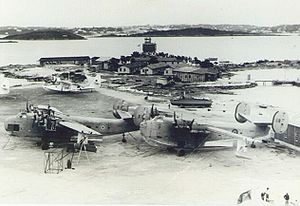
RAF Ferry Command
Encyclopedia
The RAF Ferry Command had a short life, but it spawned, in part, an organisation that lasted well beyond the war years during which it was formed.
 The practice of ferrying aircraft from US manufacturers to the UK was begun by the Atlantic Ferry Organization ("Atfero") set up by Morris W. Wilson, a banker in Montreal
The practice of ferrying aircraft from US manufacturers to the UK was begun by the Atlantic Ferry Organization ("Atfero") set up by Morris W. Wilson, a banker in Montreal
. Wilson hired civilian pilots to fly the aircraft to the UK. The pilots were then ferried back. 'Atfero hired the pilots, planned the routes, selected the airports [and] set up weather and radiocommunication stations.'
Ferry Command was formed on 20 July 1941, by the raising of the RAF Atlantic Ferry Service to Command status. Its commander for its whole existence was Air Chief Marshal
Sir Frederick Bowhill
. He was also the first commander of Ferry Command's successor, Transport Command
.
As its name suggests, the main function of Ferry Command was the ferrying
of new aircraft from factory to operational unit. Ferry Command did this over only one area of the world, rather than the more general routes that Transport Command later developed. The Command's operational area was the north Atlantic, and its responsibility was to bring the larger aircraft that had the range to do the trip over the ocean from American and Canadian factories to the RAF home Commands.
This was pioneering work: before Ferry Command, only about a hundred aircraft had attempted a North Atlantic crossing in good weather, and only about half had made it. Over the course of the war, more than 9,000 aircraft were ferried across the ocean and, by the end of the war, crossing the Atlantic had become a routine operation, presaging the inauguration of scheduled commercial air transport services after the war.
Ferry Command was subsumed into the new Transport Command on 25 March 1943 by being reduced to Group status as No. 45 Group. No. 45 Group still retained responsibility for Atlantic aircraft ferrying operations, but Transport Command was a worldwide formation, rather than a single-mission command.
Aircraft were first transported to Dorval Airport near Montreal
, and then flown to Gander Airport in Newfoundland
for the trans-Atlantic flight.
History

Montreal
Montreal is a city in Canada. It is the largest city in the province of Quebec, the second-largest city in Canada and the seventh largest in North America...
. Wilson hired civilian pilots to fly the aircraft to the UK. The pilots were then ferried back. 'Atfero hired the pilots, planned the routes, selected the airports [and] set up weather and radiocommunication stations.'
Ferry Command was formed on 20 July 1941, by the raising of the RAF Atlantic Ferry Service to Command status. Its commander for its whole existence was Air Chief Marshal
Air Chief Marshal
Air chief marshal is a senior 4-star air-officer rank which originated in and continues to be used by the Royal Air Force...
Sir Frederick Bowhill
Frederick Bowhill
Air Chief Marshal Sir Frederick William Bowhill, GBE, KCB, CMG, DSO & Bar was a senior commander in the Royal Air Force before and during World War II.-RAF career:...
. He was also the first commander of Ferry Command's successor, Transport Command
RAF Transport Command
RAF Transport Command was a Royal Air Force command that controlled all transport aircraft of the RAF. It was established on 25 March 1943 by the renaming of the RAF Ferry Command, and was subsequently renamed RAF Air Support Command in 1967.-History:...
.
As its name suggests, the main function of Ferry Command was the ferrying
Ferry flying
Ferry flying refers to delivery flights for the purpose of returning an aircraft to base, moving an aircraft from one base of operations to another or moving an aircraft to or from a maintenance facility for repairs, overhaul or other work.-Ferry permit:...
of new aircraft from factory to operational unit. Ferry Command did this over only one area of the world, rather than the more general routes that Transport Command later developed. The Command's operational area was the north Atlantic, and its responsibility was to bring the larger aircraft that had the range to do the trip over the ocean from American and Canadian factories to the RAF home Commands.
This was pioneering work: before Ferry Command, only about a hundred aircraft had attempted a North Atlantic crossing in good weather, and only about half had made it. Over the course of the war, more than 9,000 aircraft were ferried across the ocean and, by the end of the war, crossing the Atlantic had become a routine operation, presaging the inauguration of scheduled commercial air transport services after the war.
Ferry Command was subsumed into the new Transport Command on 25 March 1943 by being reduced to Group status as No. 45 Group. No. 45 Group still retained responsibility for Atlantic aircraft ferrying operations, but Transport Command was a worldwide formation, rather than a single-mission command.
Aircraft were first transported to Dorval Airport near Montreal
Montreal
Montreal is a city in Canada. It is the largest city in the province of Quebec, the second-largest city in Canada and the seventh largest in North America...
, and then flown to Gander Airport in Newfoundland
Dominion of Newfoundland
The Dominion of Newfoundland was a British Dominion from 1907 to 1949 . The Dominion of Newfoundland was situated in northeastern North America along the Atlantic coast and comprised the island of Newfoundland and Labrador on the continental mainland...
for the trans-Atlantic flight.

